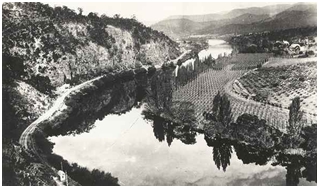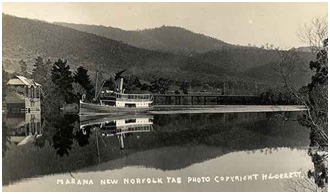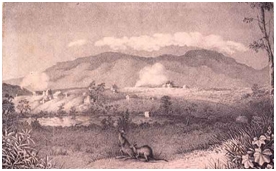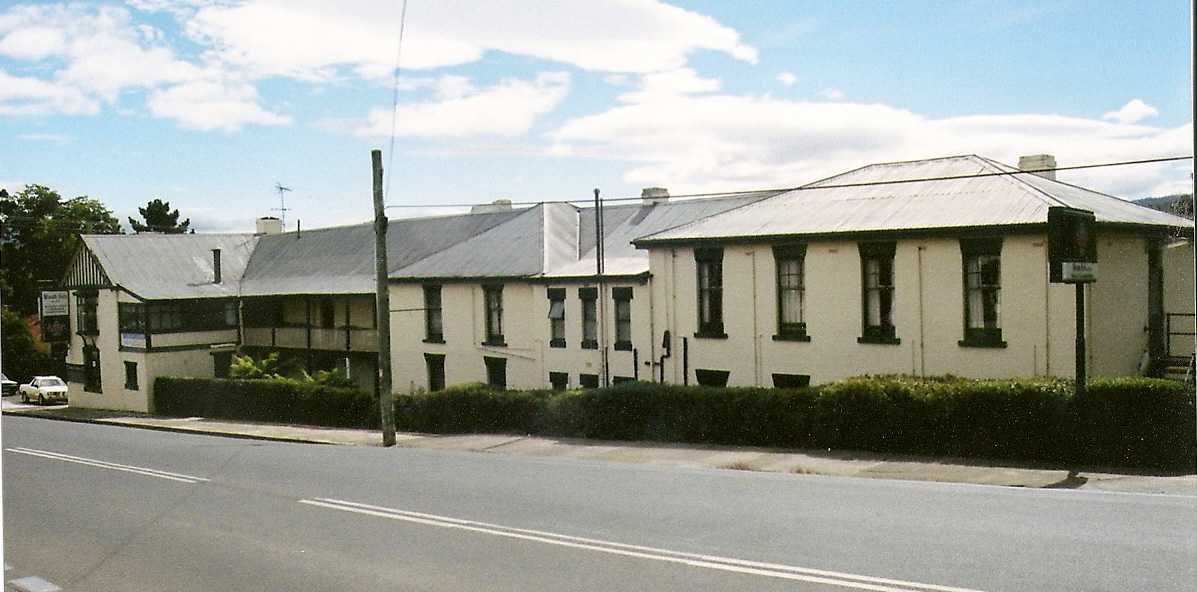New Norfolk - The town of choice!
New Norfolk was settled in 1807, based on land grants provided by the Government in an effort to develop the area. Back River just two miles from New Norfolk soon became part of that development.
Why Back River? The best explanation is that it is situated at the back of the Derwent River, amongst rolling hills,
in the shadow of Mt Dromedary and fertile river flats. Nowdays the area is known as Magna.
Bushrangers roamed the area and robbed many of the early settlers. The bushranger Martin Cash used a sandstone
cave known as Martin Cash’s Cave, to stable his horses, and further up Mt Dromadery was their hideout.
Early settlers built their homes along the flats to the foothills and were ensured of plentiful water from the streams
flowing from the Mountin. This water supply allowed the settlement to prosper.
A stroll around the cemetery behind the Methodist Church, built of brick in 1831, reveals the names of many pioneering
families. These include Shone, Triffitt, Hay and Clelland families. Early settlers include members
of the Bradshaw, Cockerill and Young families, all part of the story of the Jilletts.
Many marriages between members of these families occurred.
Robert and Elizabeth Jillett were given land at Back River and together with their children, set about farming, and raising stock.
Two substantial homes built in the district were Stanton, a brick residence,
and home of the Shone family for 130 years, and Denmark Hill,
a brick and freestone buildings. These two building still remain as historic
landmarks of the pioneering times.
“Stanton” was built on land granted by Governor Macquarie to Thomas Shone shortly after he arrived in the colony in 1816. It is constructed in red brick in a Georgian design, with a stone staircase of circular design, found only in two or three other homes in Tasmania. The bricks were made by convicts on the site, using local clay. A hand-press was used to form the bricks. The two story house haw a vast cellar whose barred windows peep little above ground level. At the back of the property was an old hop-kiln, built of stone with brick corners and window openings.
By 1843 Thomas had more than 300 acres under cultivation, and his sheep and herds of cattle grazed the river flats.
The first school was established in 1849, under difficult conditions, and in 1863 the Board of Education announced that the school would be closed due to insufficient attendance. In 1884 Thomas Shone wrote to the Board of Education requesting a public school in the area. He offered ¾ acre of land if the Board would erect a school. The school and a master’s residence were erected and Miss Ada Wills was appointed teacher. There were 20 boys and 11 girls enrolled. Miss Wills was paid 31 pounds 3 shillings and 4 pence for the 160 ½ days of school remaining in that year.
By the 1870’s hop growing was introduced, and by 1874 thee were over 50 acres under cultivation. The Shone’s had seven acres, E.A. Bradshaw had 3.5 acres, Mr. E. Cockerill had 5 acres and Mrs. C. Cockerill had 2.5 acres.
Hop growing was very hard work, involving the use of young saplings and rushes to tie the vines. Everyone helped with this task. A sickle was used to harvest the hops.
Disaster struck the industry when in 1916 there was a huge flood which swept into the valley, destroying the livelihood of the farmers. Then in 1919 the area was struck with the pneumonic flu, known then as “the plague”. So many people perished and tales of unselfish heroic acts amongst neighbours allowed many stricken families to survive. Back River today is a scene of pleasant pasture, surrounded by fruit orchards.
�
The following article appeared in the newspapers of 1816, surely giving an insight into the difficult time that were faced by the settlers in the New Norfolk district of Back River.
Extract from “The Hobart Town Gazette and Southern Reporter” Saturday 20th February 1819 as written.
Police Office, 9th January, 1819
“Whereas two men at present unknown did about nine o’clock on the night of Wednesday the 3rd day of this present month, burgariously break and enter the dwelling house of Matthew Wood, a settler at the Back River in the District of New Norfolk; and did then and there kill and murder the said M. Wood and afterwards rob the house of the goods mentioned underneath, with which they made off:
And whereas the said two robbers and murderers are at present at large, there are so require all constables and other so use their utmost exertions to discover, apprehend and lodge in life custody the said two felons.
A list of the goods carried off by the murders:
4 white calico shirts, 4 check co???; a piece of grey woolen cloth trousers (the cloth made in Sydney) a white double breasted waistcoat, 5 calico women’s caps, 1 woman;s cotton gown with red spots, 1 petticoat of the same, 2 brown linen sheets that were issued from the King’s stores, a pair of cotton sheets, a new tin baking dish about 1 foot across and 5 or 6 inches deep, 1 Durchmade gun with braff bands around the flock and barrel, ½ lb gunpowder in a bottle, about 20 lb of moist sugar 2 ½ lb of tea, a promissory note of hand drawn by Thomas Murphy for 5 pounds, payable in June next, a store receipt for 25 pounds signed by Mr Commiffary Broughten, 2 new calico shifts, a back of fine white thread and a quantity of red and brown thread.”
By order of A.W.H. Humphrey, Esq. W. English Clerk.
So life was very hard in Back River. Matthew Wood came from Norfolk Island on the Estraminas with his wife Catherine Sponsford. They were married in 1812.
She may have been the former wife of Zackariah Sponsford, who was a Third Fleet Convict, as research shows he had married
a Catherine Lewis, but he arrived back from Norfolk Island without his wife.
The Norfolk Islanders
Settlers who were brought to Van Diemen’s Land from Norfolk Island played a major part in the expansion
of the New Norfolk district. The isolation of Norfolk Island, the difficulty of getting stores ashore,
and the inability of the settlement to support itself became insuperable problems, and a complete
evacuation of the island was ordered in 1806. And so, in November 1807, the Lady Nelson arrived,
carrying the first 34 of the Norfolk Islanders to settle in the district.
By October the following year 544 people had arrived, to the great consternation of Luit. Governor Collins,
as the colony was in the grip of a famine. To add to Collin’s problems all kinds of promises of assistance had been made to the Islanders, which Collins simply could not keep.
Many settlers, and even the soldiers, were reduced to clothing themselves in skins, and if it had not been for the vast numbers of kangaroo, duck and swan, they might well have starved.
New Norfolk Historical Centre.. New Norfolk
�
A Short History of New Norfolk
Reproduced from a bookl etCompliments of the Derwent Valley Visitor Information Centre, Circle Street New Norfolk
Some facts and features are:
It has had three names - The Hills, New Norfolk, Elizabeth Town (after Governor Macquarie’s wife)
Governor Macquarie requested that it be re-named Elizabeth Town and be made the capital of Van Dieman’s Land. The Colonial Secretary in London denied his requests.
When Norfolk Island was closed many of the Norfolk Islanders were resettled at The Hills and they subsequently asked that the settlement be named New Norfolk as a reminder of their previous home.
There was a settlement prior to the arrival of the Norfolk Islanders in 1805 - 1806.
The road from Hobart to New Norfolk was the first constructed in the colony. It has been realigned in some sections.
Between Granton and New Norfolk there is a rock cairn as a memorial to the road contractor, Denis Mc Carty.
McCarty insisted that part of the contract payment be in barrels of rum. There was a dispute over the quality of the work
and McCarty died in a drowning accident before it was settled.
Willow Court, a former barracks is the oldest building in an asylum institution in Australia, (closed 2000, and is
being developed into tourist facilities and businesses)
Note Harry Jillett was a inmate, and died in 1942
The Bush Inn is claimed to be the oldest continually licensed hotel in Australia. Dame Nellie Melba stayed there when on her farewell tour, she entertained the guests by singing “Scenes that are Brightest”. The guests sat on the staircase leading to her private suite.
The Anglican Church of St Matthews in Bathurst Street is the oldest church in Tasmania, and has magnificent
stained glass windows. It is open for inspection with no charge. A particularly interesting window is in the
eastern end. This is a memorial to Nancy Hope Shoebridge, who died at sea at the age of nine years, while
on the way to England to visit her grandparents. This was in 1890 and she was buried at sea. Her parents
had the artist reproduce a picture of their child in the window. She can be seen in the background of the
Nativity scene.
The Close next to the church is also an historic building built in 1866. Crafts,
many made by local residents, and souvenirs are available, at reasonable prices,
at the Close, operated by volunteers, proceeds are used for upkeep and
restoration of the church.
There are many historic and heritage buildings within the town and throughout the Derwent Valley.
The hop industry was established firstly at New Norfolk and then at Bushy Park. An oast house (hop kiln) built at Bushy Park by one member of the Shoebridge family has biblical texts set in the external walls.
(Thomas Shone also had oast houses at his property Stanton)
At Salmon Ponds a few kilometres from New Norfolk was the first trout fish hatchery in the southern hemisphere. In a beautiful setting visitors can view the fish in ponds, read the history of the hatchery, visit the museum, have a picnic in the grounds or dine in the restaurant.
No other country town in Tasmania can offer so many historical features and beauty as New Norfolk.

The rolling hills of Back River 2010
Early New Norfolk showing the Bush Inn
History of New Norfolk 1807 - 1900 From Internet search
New Norfolk was the third planned settlement to be undertaken in Tasmania, after Hobart and Launceston. In 1803-4 when Hobart was first settled on the banks of the Derwent, it was considered important to explore this waterway and find out the potential of the surrounding areas. By 1807 the European population on the Derwent was "483 starving persons". The food supplies were so low that convicts were being sent out into the bush to kill kangaroos for meat issues from the stores.
Starting in November 1807 and on through the following year, people from the Norfolk Island penal colony were persuaded to come to Van Diemen?s Land by offers of a generous exchange of land (4 acres for each acre held on Norfolk Island), a house of similar standard to that left behind, 2 or 4 convicts to assist them in clearing their new farms, and food and clothing from the stores for 12 months. By late 1808, 544 people (soldiers, convicts and free settlers) had arrived and they put an enormous strain on the colony's fragile economy. However they did form a basis for the settlement of the district and provided many skills and profession that were lacking including 2 bakers, 2 blacksmiths, 4 bullock drivers, a butcher, 13 ex-constables, 2 gardeners, a harness maker, a milkman, a stonemason, 8 overseers, a painter & glazier, 2 saltboilers, 2 sawyers, a cooper and 2 carpenters. Although they were promised compensation for their forced move, many had the sense to realise that it would be impossible for the government ever to fulfil the wildly optimistic promises held out to them and some offered to supply themselves with housing if they could be provided with nails and a few necessary tools. Others proposed to wave all their claims for housing in exchange for stock (bengal cows and sheep) equal in value to the houses they had left behind on Norfolk.
Of the new settlers, 24% were located to Sandy Bay, 19% to New Town and Glenorchy, 27% to the eastern shore between Bridgewater and Pittwater and the Clarence Plains area. The remaining 30% came to New Norfolk. New Norfolk was at first known as "The Hills" because of its setting among hills, valleys and gentle streams. In 1811 Governor Macquarie came to visit Van Diemen?s Land. He mapped out a town site and named the town "Elizabeth Town" (after his wife) in the District of New Norfolk. The name did not catch on although it was used on and off from 1811 to 1825, but the local settlers, wanting to preserve a link with their old island home, won the day and the town was officially known as "New" Norfolk. The stream called the Thames by the locals, was renamed the "Lachlan" (pronounced Locklon) by Governor Macquarie (in honour of his son). However, although it retains the name to this very day, it is pronounced as "Lacklan" by the locals, much to the confusion of newcomers.
Governor Macquarie ordered the Surveyor to plan and mark out the township and details of grants and leases. Hobart Town Authority was instructed to afford every encouragement and facility to industrious tradesmen and useful mechanics to reside and settle as soon as the new township had been sub-divided into regular allotments. The going was tough for the early settlers and most had to be supported on government rations until 1812. There were no roads and no transport as we know it and the population was entirely dependent on river transport or following dirt tracks overland using horse-drawn vehicles and bullock wagons. But the settlement slowly grew and prospered.
New Norfolk from the other side of the Derwent circa 1834
In 1846 the first hop plants were brought in from Maria Island and this became a flourishing industry resulting in
the traditional "New Norfolk" landscape - oast houses, fields of wired poles and windbreaks of Lombardy Poplars, a
spectacular sight in autumn.
The Derwent Valley was rich in soil and timber and by 1902, had began to develop at a rapid pace. One of the contributing
factors was the extension of the railway line. This much needed facility brought greater prosperity to the rural
communities and in 1907 the Hydro-Electric Power & Metallurgical Company commenced operations at the Great Lake.
Hobart was first illuminated by the Hobart Gas Company on 1 January, 1913 but three years later changed over to electricity
from the Great Lakes Works. In 1915 the Hydro Electric Department was requested by the Minister for Lands and Works
to report on the possibility of an electricity supply for New Norfolk.
River steamers were an essential part of New Norfolk's development, among them the SS Marana, which ended its days as a fishing trawler at Victoria; the Maweena which eventually burnt; the Emu, which sank later near the New Norfolk bridge and is still there; and the Monarch which sank at the Lime Kilns. Flooding in the lower reaches of the Derwent River has been a periodic event and New Norfolk has rebuilt the bridge, linking both sides of the town, four times. The existence of Meadowbank Dam should remedy this situation.
The historic problems of wars and pestilence took their toll here too. Men served in the Boer War which began in October 1899 and ended in May 1902 and then the First and Second World Wars. Floods and the Pneumonic Flu in 1917 decimated the population of the island as it did across the world.
Derwent River with Hops growing
In 1810, John Oxley wrote:
New Norfolk... A considerable portion of the Norfolk [Island] Settlers have chosen to settle on the Upper part of the river; their district is named New Norfolk and is represented as being a most delightful Country, the land contiguous to the Banks of the River being exceedingly fertile and not liable to flood ; extensive plains and rising Ground afford pasturage for any number of Cattle ; a number of small rivulets, intersecting the Country in every direction is an advantage the Country near the Sea Coast is deprived of ; the Main River, being navigable for Boats for a considerable distance, affords an easy communication with he principle Settlement [of Hobart].
These lands have not been settled for more than eighteen months, And appearances are so favourable as to Warrant the Expectation that with proper Care and Management a short Space of time will preclude the Necessity of further Importations of Grain.
Though Oxley painted a rosy picture of the New Norfolk area, the Norfolk Island settlers were still arguing that the terms of their relocation had not been met in full, particularly in respect of the labour promised them. This dispute was ongoing, and even in 1812 Lieutenant Governor Macquarie was still trying to resolve it.
...I must recommend to you in the Strongest manner to pay particular attention to the Distribution of the Eighty Male Convicts now proceeding to the Derwent on board the [ship] Ruby. You are to retain Twenty Men out of that number for the use of the Government, including Mechanics ; and you are to distribute the remaining Sixty Men amongst that Class of People called the Norfolk Island Settlers, in liquidation of their long standing Claims for Government Labourers. In making this Distribution, the Strictest impartiality must be observed ; and... it will be impossible to liquidate the whole of the Claims of the Norfolk Island Settlers for Men...17
Also inevitable is that once an area becomes settled by farmers, others will follow, providing businesses and services any community requires. And with these first entrepreneurs and community groups the Government is usually there too, often after these business have established themselves, sometimes before.
Issuing instruction to James Meechan, the colonies Surveyor General, Macquarie said:
You will mark out the new Township of Elizabeth Town (named so by me when at the Derwent in November last) [after his wife] exactly on the same Ground I have already pointed out for it on the Right Bank of the River Derwent, opposite and adjoining to the District of New Norfolk ; laying the Cite of the Town exactly on the same Plan and Principle as that of George-Town with regard to the Centre Square, Streets... with the exception however of the few Allotments I have already promised to some few Individuals who have promised to come to reside there immediately...
In 1812 Governor Macquarie directed:
Having deemed it advisable, when lately at the Derwent and on my visit of Inspection to the District of New Norfolk, to examine and to mark out an eligible Situation for a Township I have named Elizabeth Town , I have to direct that every facility and encouragement in your power to Sober, industrious Tradesmen, and useful Mechanics to go to reside and Settle there, as soon as the Township has been subdivided into regular Allotments by the Surveyor.
Along with Turriff Lodge and John Terrys (flour) Mill, sited where the Lachlan and the Derwent Rivers met (now the Oast House and Tynwald), one of the first permanent buildings erected, high on the banks of the river and overlooking its wonderful valley, was the public house known as the “Bush Inn”.
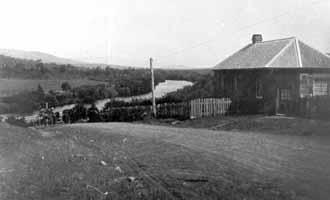
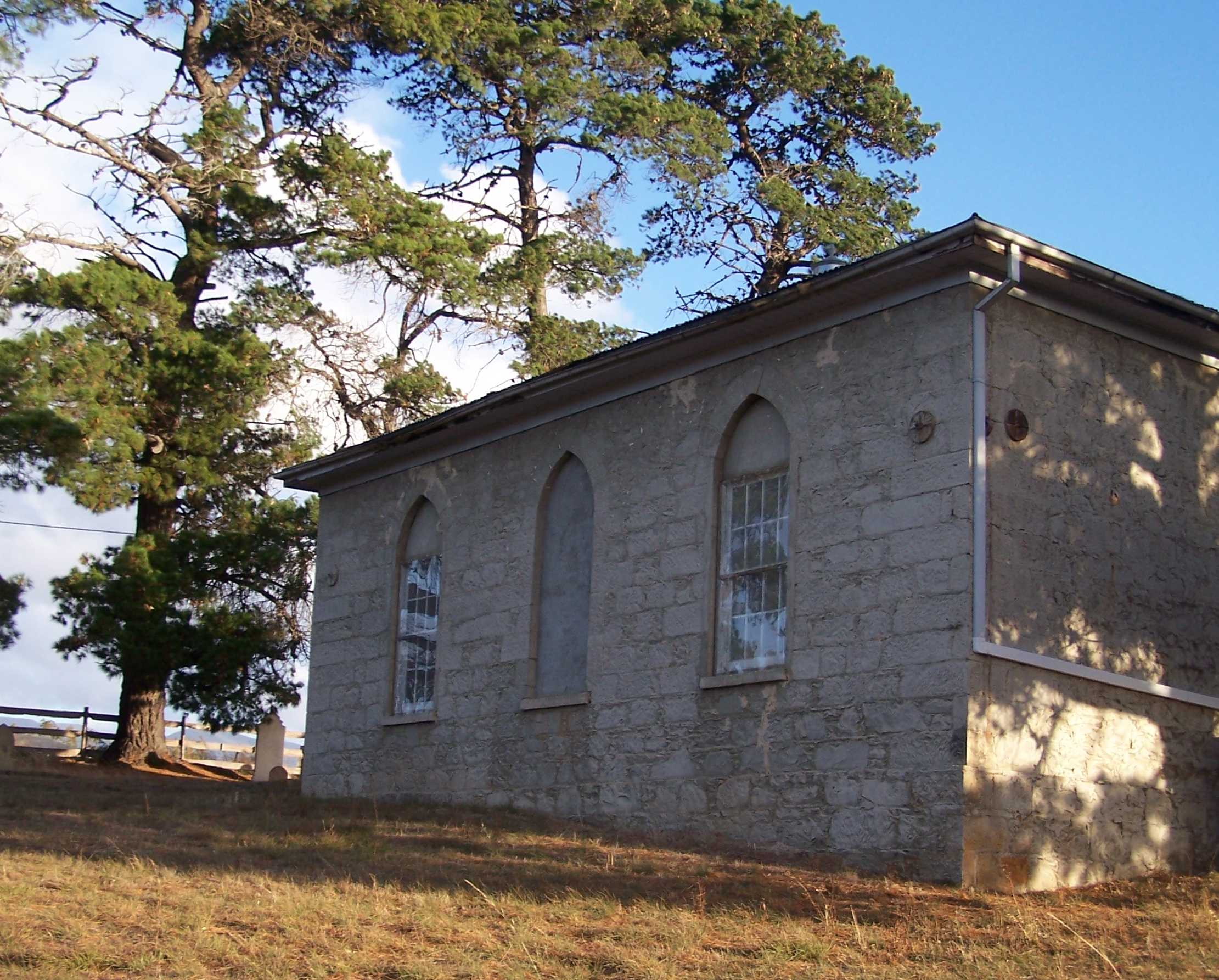
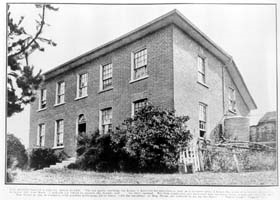
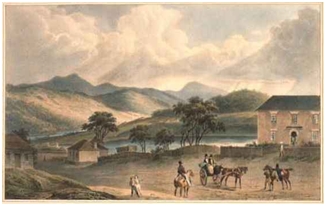
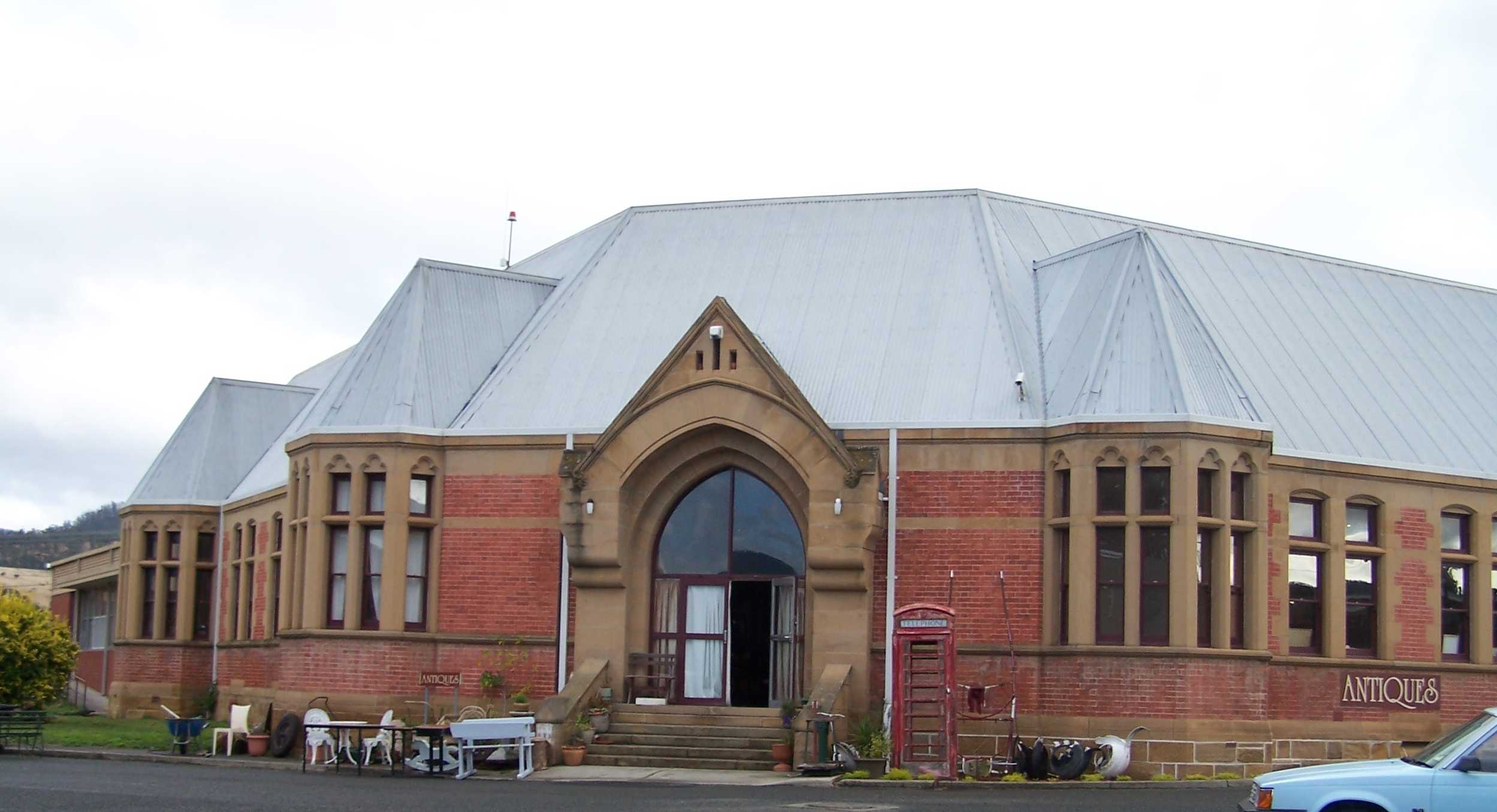
New Norfolk Mental Asylum Largest in Australia now an Antiques Store
The area was named by the Norfolk Islander’s who were sent to Van Dieman’s Land when the first settlement on Norfolk Island was disbanded. The settlers chose the name as a reminder of what they had left behind when they were made to relocate.
Betty King, (Elizabeth Thackerly convict) who was supposed to be the first white woman to set foot on Australian soil, (she jumped off the ship when it landed at Botany Bay), was a settler, along with her husband Sam King. They came to live at Back River in 1810, and the area they settled is still known as King’s Rocks today.








